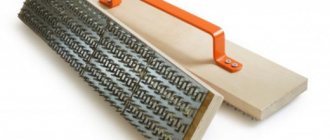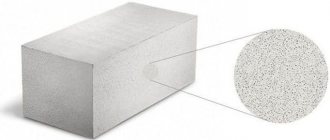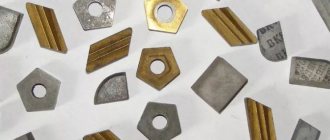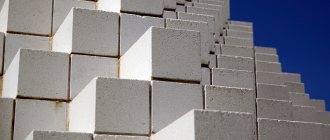Cutting gas blocks can be done with a regular carpenter's hacksaw. However, the length of the standard tool is too short for processing wide blocks. For such work, a special hacksaw with a long base and large teeth is used.
Cutting aerated concrete blocks is a necessary operation that has to be performed during any construction. The dimensions of the partitions are never so well calculated that the blocks can be laid entirely, without adjusting one of them to length. Aerated concrete is placed on an adhesive composition with thin seams, so the quality of the cut must be very high, and the cutting tool must be of high quality and durable. Sometimes you have to cut not in a straight line, or along the block. Such operations, which require high precision and quality of cutting, are performed using specialized tools.
Application in construction
It is already known that a foam block hacksaw can be used to cut foam and aerated concrete blocks, as well as other similar building materials. This means that this hacksaw is used on construction sites during the construction of buildings, in construction on summer cottages, wherever foam concrete can be used.
You can work with such material using a band saw or reciprocating saw, a circular saw with a disk designed for this, but all these tools are expensive. They are used by organizations and teams with large volumes of construction. For private use, the best option would be a hand saw for aerated concrete. The characteristic features of this tool do not allow it to be used for working with other materials, such as wood or metal. It is more advisable to use it only for its intended purpose.
Features of aerated concrete
Aerated concrete is a building material from the group of cellular concretes. It has a porous structure, due to which the density and hardness are much lower than those of traditional, dense grades of concrete. In construction, aerated concrete is used as a material for private low-rise housing construction, as well as for the construction of relatively small structures for service and auxiliary purposes.
From a technology point of view, aerated concrete is a convenient and practical material. It is lightweight, the blocks are large enough, which in total allows for high installation speed with low equipment consumption and a small amount of labor investment. The material is laid according to its own rules, determined by the structure and working properties of aerated concrete. Its main difference is the even, calibrated shape of the blocks, which makes it possible to obtain neat masonry without flaws or distortions.
The material is hygroscopic, which forces the use of a special adhesive composition that provides a thin, durable seam. Ordinary masonry mortar is not suitable, since the water from it is absorbed into the blocks too quickly, and the composition cannot crystallize under normal conditions. The strength of the seams is reduced, which affects the overall load-bearing capacity of walls or other structures. There are special adhesive compositions for aerated concrete on sale in the form of a dry mixture or a ready-made paste in tubes. You cannot use other types of adhesives; this is a direct violation of SNiP requirements.
Description of the tool
Externally, a saw for aerated concrete is no different from ordinary hacksaws for woodworking. It consists of a handle and a cutting blade. The work is done manually using swinging movements. The main feature of the tool is that the teeth have a unique design.
All types of hacksaws of this type are equipped with reinforced teeth coated with Teflon to increase the hardness and rigidity of the saw part. Another advantage of such a hacksaw is the small pobedite soldering on the teeth of the blade, which allows you to improve the quality and efficiency of working with aerated concrete or foam concrete. Components of the tool:
- canvas;
- coating;
- teeth
A hacksaw for working with wood can have either a flexible or rigid blade. The hacksaw for aerated concrete with Pobedit tips is equipped with a particularly hard base and increased thickness. Such a blade will not bend or play when cutting aerated concrete. Positive aspects of precision cutting:
- the adhesive mixture is saved due to precise fit;
- time is saved, since there is no need to refine the surface with a plane or float.
Where is it used?
Quite often, to cut aerated concrete, inexperienced craftsmen take an ordinary hacksaw for wood, which usually ends in damage to the tool and poor quality of the cut. A regular hacksaw is not designed to work specifically with porous aerated concrete, and you need to choose the right tool.
So, sawing with a hand hacksaw will take on average 5 times more time and effort than using a special saw for a gas block. The main distinguishing feature of the tool is the presence of special pobedit (carbide) soldering on all teeth. The pobedite element has increased strength and is used for a reason.
What problems are solved by pobedite soldering on hacksaw teeth:
- Significant extension of the service life of the tool - thanks to strong soldering, the teeth do not wear out or wear out during the cutting process, so you can cut many blocks without worrying about the rapid failure of the saw.
- Facilitating and increasing the efficiency of the sawing procedure - teeth with pobedit tips cope with the material easier and faster (albeit with the appearance of a large amount of dust, and therefore it is necessary to work in a respirator).
- Significant savings due to the absence of the need to spend money on expensive gasoline and electric tools for cutting aerated concrete.
What is a hand saw for aerated concrete blocks used for:
- Dividing one block in half to produce smaller elements.
- Cutting off excess in isolated cases (when creating additional elements).
- Refinement of the existing form of aerated block (when some unusual structures are created).
The design of a hacksaw for aerated concrete is very simple: the working part is a blade with teeth located on one side, and the handle is made in the form of a handle, which the master holds during the implementation of the work. The saw is completely reminiscent of the design of a wood hacksaw, with the only difference being that the teeth are usually made of a different shape and design.
Criterias of choice
When purchasing a hacksaw for aerated concrete, you should know its parameters and features, as well as for what volume of work this tool will be used. You need to pay attention to the thickness and height of the blade, length, what material it is made of, whether the handle is comfortable and who the manufacturer is.
The thickness and height of the canvas depends on the size of the foam blocks you will be working with. A thick and tall blade (100 - 120 mm high and 0.5 - 1.5 mm thick) will be needed when working with solid blocks of aerated concrete or foam concrete. The processing in this case will be “rough” , since the cuts will have a rough, rough surface.
If you need more filigree and delicate work (usually when processing small areas of concrete), you need to select a hacksaw with a blade thickness of 0.2 - 0.5 mm and a height of 50 - 70 mm. The fine teeth of such a tool produce smooth and neat cuts.
The length of the blade plays an important role when working with a hacksaw on concrete. It varies from 300 mm to 700 mm. The length must exceed 2 times the thickness of the concrete block, otherwise there will be some inconvenience in work. In the manufacture of hacksaws of this type hardened or stainless steel is usually used , the teeth of the blade are strengthened with pobedit tips, and to extend the service life it is coated with an additional protective layer.
About the types of hacksaws for cutting foam concrete
Before choosing a tool suitable for performing the tasks, you need to study all existing types and the most common options.
Classification criteria for hacksaws for aerated concrete:
- type of drive
– the saw can be manual, gasoline, or electric. Hand saws are similar to hacksaws for wood, electric/chainsaws require a standard design with the need to install disks/saw chain with pobedite soldering before starting work.
- Blade type
– hand and reciprocating tools, as well as disk and automatic units.
If the craftsman already has an electric/gasoline saw, to work with a gas block it is enough to purchase a special chain with pobedit soldered on all teeth. But such a chain will cost 2-3 times more than a similar consumable for wood. Therefore, many people prefer to buy a hand saw for not too large-scale work.
Types of hand saws and their characteristics:
- Blade length
– varies in the range of 50-70 centimeters. The longer the blade, the more possibilities: it will be possible to cut an aerated concrete block across/lengthwise.
- Canvas material
– usually good hacksaws are made from stainless and alloy steels, which demonstrate high strength and allow you to cut even shell rock.
- Blade thickness
– the more, the better, but the cost also increases similarly. Thick blades do not deform or bend during operation, therefore they give a straighter and more even cut, without distortions. To obtain an even cut, craftsmen also recommend using a square or corner template.
- Soldering on teeth
– a very important point on which the service life of the tool and, in many respects, the quality of cutting depend. In addition to pobedit, monocarbide, rapid, etc. are also used for soldering.
Recommendations for performing work
To use the tool more effectively, you need to follow several recommendations. This will help reduce the consumption of effort and time. General recommendations for work:
- Do not work on aerated concrete wet from rain, as dust will stick and impede the movement of the hacksaw.
- Make a miter box (can be made from wood waste). Place it on top of the block, and the canvas will accurately follow the created grooves.
- Correlate the length of the blade and the span to ensure complete removal of concrete chips.
- Mark the blocks using a square.
Choosing the best tool for the job is the main condition for performing high-quality masonry. It is not difficult to choose one, since there is a wide variety of types of hacksaws for aerated concrete from various companies and manufacturers on sale.
Processing of aerated concrete
The process of laying aerated concrete is constantly accompanied by the need to process the blocks. It is necessary to eliminate defects obtained during manufacturing, align broken blocks, and adjust the dimensions of briquettes in length or along other axes. All this work is performed using different tools designed to solve specific problems. All types of processing can be conditionally divided into two groups:
- surface leveling (sharpening and grinding);
- cutting blocks in a given direction.
Most often cutting of gas blocks is required. Grinding or sharpening are operations that are performed only occasionally, as needed. The shape of the gas blocks is smooth and precise, they are practically free of defects. Treatment is required only if it is necessary to restore damaged or split elements. Cutting is necessary when laying each row of walls, partitions or other areas. When performing relatively small amounts of work, hand tools are used. Aerated concrete is a relatively soft material; the feel when cutting can be compared to wood.
Differences from standard hacksaws
The differences between a professional saw for aerated concrete and a carpenter’s hacksaw come down to the following:
- Increased length of the blade , which will allow for transverse and longitudinal cutting of blocks.
- It differs in the direction of increasing the thickness of the steel that is used for the fabric produced. This characteristic affects the quality of work, the absence of deformations and distortions of the tool.
- On saws for aerated concrete, additional soldering is provided on the teeth (which is noteworthy, not on each one, but through the tooth). The teeth of the cutting edge are large, which ensures a long service life of the hacksaw. More expensive modifications have rapid blades or teeth, the attachments of which are made of pobedit, a metal-ceramic composite that includes cobalt, monocarbide and tungsten. This allows you to reduce the load on the canvas and increase the service life of the product. The resource of such a tool is designed to process approximately twenty to thirty cubic meters of blocks.
Important!
A hand saw is used when you need to cut a small volume of workpieces. If you want to speed up the work process and save energy, it is recommended to use a power tool, namely a reciprocating saw with a special blade. Making your own U-blocks using hand tools will also be problematic.
Mistakes made when cutting aerated concrete
Many inexperienced builders try to cut aerated concrete with tools that are not suitable for this purpose. Some people use a grinder, which is inconvenient and does not give a quality cut. The overhang of the diamond blade is too small to allow cutting off the entire thickness of the block at once. It has to be turned, which takes time and degrades the quality of work. In addition, a huge amount of dust arises, complicating the work and making accurate visual control impossible.
Another common mistake is trying to cut aerated concrete with a chainsaw. This does not give positive results - firstly, the thickness of the cut is too large, and secondly, the chainsaw chain is not designed to work with such materials. The abrasive properties of aerated concrete are higher than those of wood, which causes strong heating of the chain, its sagging and beating. The cutting edges of the tool quickly lose their working qualities, and instead of the expected result, the chainsaw is rendered inoperable.
To summarize, it should be noted that the choice of tool always depends on the capabilities and skills of the master. Using unusual devices does not immediately produce a positive effect; it requires time and effort. Some amount of material will inevitably be damaged, which construction conditions do not always allow. A familiar and familiar saw for gas silicate blocks will give a greater effect than a complex mechanical device that you have never had to deal with before. The main condition is to use only a specialized tool, well sharpened and prepared for work. This will allow you to obtain maximum quality and speed of processing of gas blocks.
Features of choice
When choosing a brand or model of a hacksaw, you should pay attention to the following features:
- For small volumes of work and the construction of internal partitions, it is worth choosing a hand tool. If you are building a large house, with bay windows and other complex elements, immediately look towards electric saws.
- Product quality . It is not recommended to buy handicraft hacksaws of dubious production; you should pay attention to the products of trusted companies. For example, Yutong products will become an affordable and practical solution. Delta, which is offered by a domestic manufacturer, will also be a budget option. It has high strength and can easily be used if necessary to make precise adjustments of foam concrete and expanded clay blocks.
- the length of the canvas based on the size of your blocks.
- The saw for gas silicate blocks can be with one handle, as well as with two . The choice of a two-handed tool affects the convenience of sawing workpieces, but can make the tool heavier. Also, in this case, you cannot do without a partner. However, it is better to cut large blocks with a two-handed hacksaw.
Advice
Choose a hacksaw with a hard blade. The manufacturing company fades into the background here.
For my construction project, I bought two hand saws:
- Hacksaw from Leroy Merlin store . Low price. Hard fabric. It cuts wonderfully. But she has a short canvas. This saw is only suitable for partition blocks up to 200mm thick.
- Standard hacksaw with long blade . All the copies presented for sale were similar and had a flexible fabric. Out of habit, at first he was pulled to the side and ended up with a crooked cut. But you can adapt to the tool by following a special technology for sawing blocks. I talk about my experience in the article How to cut aerated concrete. And I would recommend looking towards a two-handed saw if the house is not being built alone.
Tool Application
There is an opinion that you can work with aerated concrete with any saw (carpenter's saw). This is an incorrect statement. After all, gas silicate is not only lightweight, but also a very durable material. An important characteristic of the material is abrasiveness, in other words, the ability to abrade and grind surfaces. If the saw is standard, it will quickly become unusable, and for this reason only special sets of hacksaws are used.
The use of a hacksaw occurs in the following cases:
- If the task is to refine individual elements of the form, obtain strong cellular bricks created exclusively in the required size.
- When the need arises for the production of additional blocks during assembly fitting of elements during the laying of walls and the construction of an armored belt.











